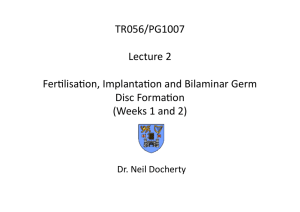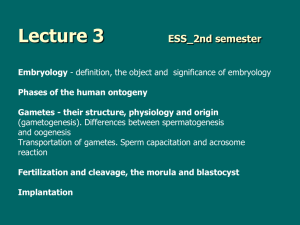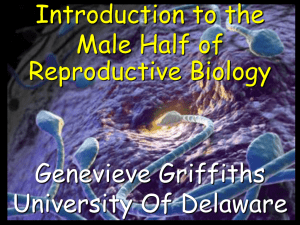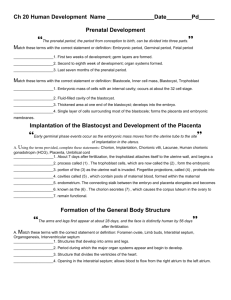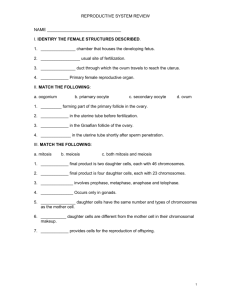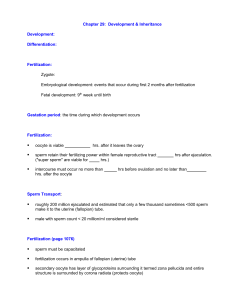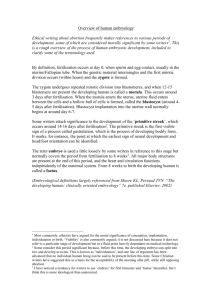Document 14124596
advertisement
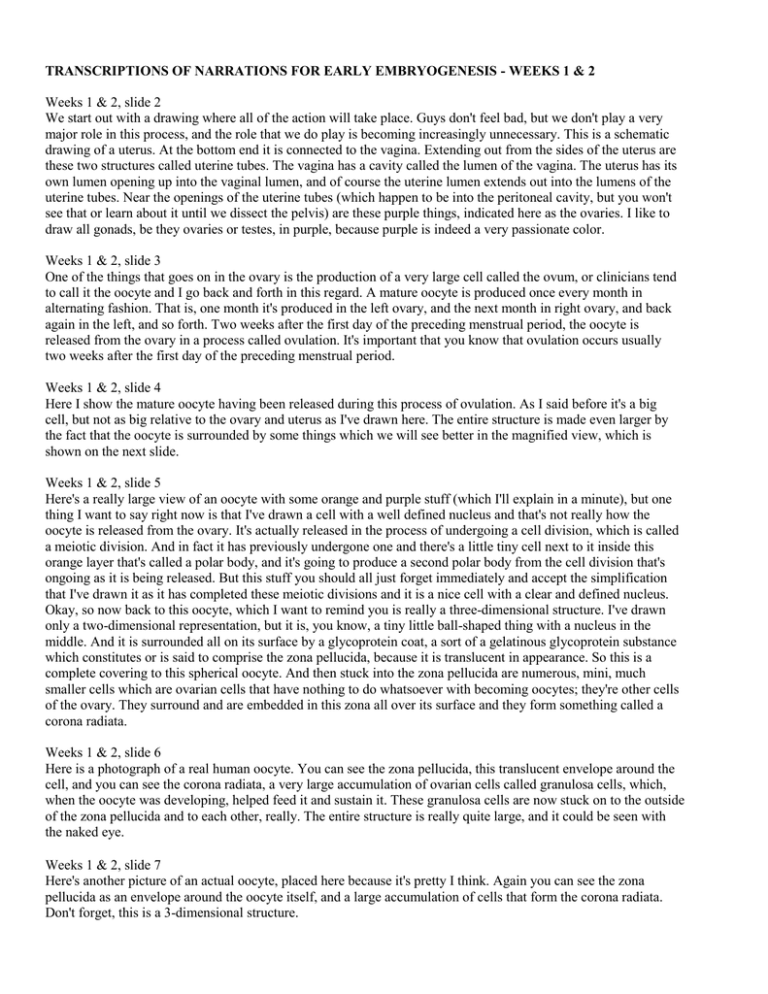
TRANSCRIPTIONS OF NARRATIONS FOR EARLY EMBRYOGENESIS - WEEKS 1 & 2 Weeks 1 & 2, slide 2 We start out with a drawing where all of the action will take place. Guys don't feel bad, but we don't play a very major role in this process, and the role that we do play is becoming increasingly unnecessary. This is a schematic drawing of a uterus. At the bottom end it is connected to the vagina. Extending out from the sides of the uterus are these two structures called uterine tubes. The vagina has a cavity called the lumen of the vagina. The uterus has its own lumen opening up into the vaginal lumen, and of course the uterine lumen extends out into the lumens of the uterine tubes. Near the openings of the uterine tubes (which happen to be into the peritoneal cavity, but you won't see that or learn about it until we dissect the pelvis) are these purple things, indicated here as the ovaries. I like to draw all gonads, be they ovaries or testes, in purple, because purple is indeed a very passionate color. Weeks 1 & 2, slide 3 One of the things that goes on in the ovary is the production of a very large cell called the ovum, or clinicians tend to call it the oocyte and I go back and forth in this regard. A mature oocyte is produced once every month in alternating fashion. That is, one month it's produced in the left ovary, and the next month in right ovary, and back again in the left, and so forth. Two weeks after the first day of the preceding menstrual period, the oocyte is released from the ovary in a process called ovulation. It's important that you know that ovulation occurs usually two weeks after the first day of the preceding menstrual period. Weeks 1 & 2, slide 4 Here I show the mature oocyte having been released during this process of ovulation. As I said before it's a big cell, but not as big relative to the ovary and uterus as I've drawn here. The entire structure is made even larger by the fact that the oocyte is surrounded by some things which we will see better in the magnified view, which is shown on the next slide. Weeks 1 & 2, slide 5 Here's a really large view of an oocyte with some orange and purple stuff (which I'll explain in a minute), but one thing I want to say right now is that I've drawn a cell with a well defined nucleus and that's not really how the oocyte is released from the ovary. It's actually released in the process of undergoing a cell division, which is called a meiotic division. And in fact it has previously undergone one and there's a little tiny cell next to it inside this orange layer that's called a polar body, and it's going to produce a second polar body from the cell division that's ongoing as it is being released. But this stuff you should all just forget immediately and accept the simplification that I've drawn it as it has completed these meiotic divisions and it is a nice cell with a clear and defined nucleus. Okay, so now back to this oocyte, which I want to remind you is really a three-dimensional structure. I've drawn only a two-dimensional representation, but it is, you know, a tiny little ball-shaped thing with a nucleus in the middle. And it is surrounded all on its surface by a glycoprotein coat, a sort of a gelatinous glycoprotein substance which constitutes or is said to comprise the zona pellucida, because it is translucent in appearance. So this is a complete covering to this spherical oocyte. And then stuck into the zona pellucida are numerous, mini, much smaller cells which are ovarian cells that have nothing to do whatsoever with becoming oocytes; they're other cells of the ovary. They surround and are embedded in this zona all over its surface and they form something called a corona radiata. Weeks 1 & 2, slide 6 Here is a photograph of a real human oocyte. You can see the zona pellucida, this translucent envelope around the cell, and you can see the corona radiata, a very large accumulation of ovarian cells called granulosa cells, which, when the oocyte was developing, helped feed it and sustain it. These granulosa cells are now stuck on to the outside of the zona pellucida and to each other, really. The entire structure is really quite large, and it could be seen with the naked eye. Weeks 1 & 2, slide 7 Here's another picture of an actual oocyte, placed here because it's pretty I think. Again you can see the zona pellucida as an envelope around the oocyte itself, and a large accumulation of cells that form the corona radiata. Don't forget, this is a 3-dimensional structure. Weeks 1 & 2, slide 8 Here I show the oocyte with its zona pellucida and, faintly seen, corona radiata entering the lateral opening of the uterine tube. Now, in the previous slide that looked like this I showed the oocyte popping out of the ovum, and it looks now like it's traveled a little bit of a distance to get into the uterine tube. But in real life, these little finger-like projections at the end of the uterine tube clasp the ovary - they almost grab it, and the ovum at ovulation is released and immediately enters the lumen of the uterine tube. So, there is no long trip involved, as my drawings have sort of indicated. Weeks 1 & 2, slide 9 This shows a picture naming the different parts of the uterine tube. It has a part that is embedded, said to be embedded within the thick muscular wall of the uterus, that's the interstitial portion of the uterine tube very narrow lumen. The part that extends out beyond the borders of the uterus, the first medial half is also of a very narrow lumen and that's called the isthmus, isthmus means narrow passageway. Then the lateral half uterine tube is wider. First we have the ampulla and then it terminates into a remarkably wider portion called the infundibulum. So the oocyte with its zona pellucida and corona radiata enter the infundibulum, and then enter the ampulla, and they find themselves to be or it finds itself to be too large - this massive structure (massive is relative, you know ) - too large to pass into the narrow isthmus. So it floats around in the ampulla of the uterine tube. Weeks 1 & 2, slide 10 Now we show the role of guys. These blue things sitting in the vaginal lumen are meant to represent sperm. This is an inaccurate drawing in several ways: #1, they are not blue, #2, they are not nearly as large as this. They are tiny little things, much much (infinitesimally) smaller really than the oocyte. And many more than three are deposited the average young male ejaculate is about 300 million sperm, very few of which ever get in the vicinity of the oocyte. They have to swim all the way up the uterine lumen, and then they have to swim out of the uterine tube lumen, and half of them are going to go to the wrong side anyway. And probably about 1 in a million of the deposited sperm ever get in the vicinity of an oocyte. Most of them end up dying in the uterus or in the uterine tubes themselves. Now the oocyte is hanging out in the ampulla of the uterine tube, hopeful, or fearful, of a sperm reaching it. And the average life of an oocyte is about 12-24 hours, so that it starts to die really about 12 hours following ovulation, by 24 hours all of them are dead. And so if a sperm is going to successfully fertilize an oocyte, it best get there in the first 12 hours after fertilization. Weeks 1 & 2, slide 11 Here's a very large, a very great enlargement of a sperm. It's an oval shaped thing at one end and then it's got this squiggly little tail coming out the other. The oval shaped thing is called the head of the sperm. Largely it is just a sac of membrane around the male DNA. The tail that comes out is the thing that does wiggle around to propel the sperm through the uterine and tubal lumens assisted by motions of those structures. More important for us is this yellow structure, which sits on the front end of the DNA sac, that's called the acrosomal cap. It is a membrane enclosed bag of enzymes that are very important for the fertilization process. And then the entire head is surrounded by the stuff I've called gunk, which is not really gunk, but is a material derived from seminal fluid which is secreted largely by the prostate gland (maybe a little bit by seminal vesicles). Most of the ejaculate is seminal fluid. It's got these hundreds of millions of tiny sperm floating around in it. Weeks 1 & 2, slide 12 And now some sperm may reach the vicinity of the oocyte within an hour, some take longer. The fact of the matter is that no sperm which has this gunk on its head is capable of fertilizing an oocyte. This gunk has got to be removed and this process of removal is called capacitation of the sperm and this stuff is removed by the enzymes or chemicals that are in the uterine tube. So the sperm in the environment of the uterine tube is capacitated as these enzymes or chemicals remove the gunk. A sperm which has not been capacitated cannot fertilize. And in fact if you take fresh ejaculate and you take an oocyte out of a woman and you attempt an in vitro fertilization by mixing the two, nothing will happen because the sperm has not been capacitated. Their heads are still covered with this gunk. You, as a physician, will have to provide some chemical, I don't know what it is, that does the capacitation, that removes this gunk. I don't know how long it takes in an in vitro fertilization to expose sperm to these chemicals that capacitate it, however in real life, in a uterine tube, a sperm has to be exposed for six or seven hours to the environment of the uterine tube before it is capacitated and able to fertilize an oocyte. Weeks 1 & 2, slide 13 Here is a sperm that has been capacitated, the gunk has been removed, and what this has done is expose on the surface of the acrosomal cap receptors that have their matching counterparts on the zona pellucida. So with zona receptors on the acrosomal cap now being exposed by virtue of capacitation, the sperm can attach to the zona pellucida of the oocyte. Weeks 1 & 2, slide 14 Here is a picture showing the outer surface of the acrosomal cap attaching to the zona pellucida by means of this receptor interaction. Weeks 1 & 2, slide 15 The two membranes fuse. The DNA that is within the head of the sperm is released into the cytoplasm of the oocyte, and then we have what is called the zygote. This is now the beginning of all that will genuinely happen over the course of the next nine months, and in fact brings me to the question of timing, and I want you to know a bit about details of that. Weeks 1 & 2, slide 16 In this course, we do not place great emphasis on knowing what is going at every single day in the age of the embryo or fetus. But from time to time we'll want to refer to specific events in relationship to fetal or embryonic age. And in that case, it makes sense to measure it from the day of fertilization, that is when the zygote is created, and that is how we will do it most often in this course. When you do that, the average age at delivery, as this slide says, is 38 weeks; that is, on average, 38 weeks after the zygote is created a neonate is delivered. Doctors do not refer to gestational age as the time from fertilization. They usually start counting from the first day of the preceding last normal menstrual period, because that in fact is what the patient can report to them. You know that ovulation occurs 14 days after the first day of the preceding menstrual period, and fertilization occurs soon after ovulation. So, it is obvious that the actual fertilization age of an embryo or fetus is 2 weeks less than had you measured it from the first day of the last normal menstrual period. If the average period of gestation is 38 weeks from the time of fertilization, then the average period of gestation is 40 weeks when you measure it from the first day of the last normal menstrual period. The bottom part of this slide tells how you can inform a patient when the anticipated date of delivery is. If you count back 3 months, and add a week. For example, let's say a patient comes in and tells you that the first day of her last normal menstrual period was January 18th. If you want to tell her when she can expect to have her baby, you count back 3 months - December 18th, to November 18th, October 18th - then you add a week - October 25th. Do the math, by some magic this turns out to be 40 weeks from the first day of the last normal menstrual period. Weeks 1 & 2, slide 17 OK, after that digression we return back to our zygote. And now I've drawn in pink some things which have been there all along, in the oocyte, but I've never bothered to mention because I didn't want to clutter up the slide. These are little tiny bags of enzymes called cortical granules, and they have been there in the periphery of the oocyte cytoplasm all along.Now when fertilization occurs, for reason I don't understand, it induces these little sacs of enzymes these cortical granules - to move toward the membrane of the oocyte, fuse with it, and release their enzymes into the zona pellucida. These enzymes bring about two important events. First, they cause dispersal of the cells of the corona radiata. These cells detach from the zona pellucida, move off somewhere and then die within the uterine tubes. As you can imagine, this has a secondary effect of reducing the volume of this structure quite considerably. Go back and look at some of those actual pictures of an oocyte surrounded by a corona radiata and imagine how much smaller it's going to be without that corona. The second primary effect of these cortical enzymes is that they induce a change in the three dimensional structure of the glycoproteins of the zona itself, and it makes these glycoproteins invulnerable to digestion by acrosomal enzymes. So that means that any other sperm that may come along and attach itself to the zona, no longer has the ability to dissolve a tunnel through the zona and to fertilize the oocyte, which in fact by now is actually a zygote. This change in the glycoproteins of the zona pellucida is referred to as the zona reaction, and it therefore is the event which prevents multiple sperm from fertilizing an oocyte. If more than one sperm were to do this, I mean if the zona reaction should fail in its job, then you have a condition known as polyspermy, which is usually fatal to the zygote because it will have an abnormal number of chromosomes. Weeks 1 & 2, slide 18 The reduction in volume of this structure now means that it is small enough to leave the ampulla of the uterine tube, and enter the narrower isthmus region of the uterine tube, and it does that. And it travels down this narrow region of the uterine tube and into the uterus, the entire trip taking about 3 ½ days from the moment of fertilization. While it is doing this it will be undergoing some changes, and those changes will be discussed in the next few slides. Weeks 1 & 2, slide 19 Well what happens during this leisurely journey down the uterine tube into the uterus is that the zygote divides. And this also takes place at a fairly leisurely, so that by 30 hours of age we've only reached the stage of a 2-celled embryo. By the way, sometimes this is called a pre- embryo by the physicians but I don't make that distinction. At any rate, this division is occurring within the confines of the zona pellucida, which has not changed its shape or size. And therefore, we have a situation in which the proteins and genetic material and fluids are simply being partitioned into smaller packets. We don't have any actual growth in the size of the embryo. Weeks 1 & 2, slide 20 And this a photograph of a real human 2-cell embryo, or pre-embryo, with its zona pellucida surrounding it. It took about a day to get to this stage. Weeks 1 & 2, slide 21 After a little bit of more time, I don't know how much, the pre-embryo has divided into four cells, all of this I remind you takes place within the sphere of zona pellucida, which has not changed its size. Weeks 1 & 2, slide 22 Here is a pretty picture of a real 4-cell human embryo: nice zona pellucida, and on the left, a sperm that came in late and could not dissolve its way through the zona. Weeks 1 & 2, slide 23 A photo of a real 8-cell embryo. Weeks 1 & 2, slide 24 This is my schematic drawing of a 16-cell morula. Each cell gets a name applied to it; the Greek word blastos means "the thing that will become" or "the bud" or "the germ of something," and the Greek word meros means "a part of." So each cell of the 16 cells is called a blastomere because they are "a part of the thing that will become." The "thing that will become" is the morula itself, which is going to become the baby. Weeks 1 & 2, slide 25 Here's the way things look a few hours later. Things are speeding up a little bit. Now we have a 32- celled embryo. It's still called a morula. I guess it still looks like a mulberry. And it's still floating around within the uterine cavity. I want to remind you that all these cell divisions are taking place within the confines of the envelope provided by the zona pellucida. When the embryo gets to this 32-cell morula stage, as I have drawn at a variety of locations, intercellular fluid coalesces to form these tiny microdroplets. Weeks 1 & 2, slide 26 Here we are at about 4 days of age. I'm sure the cell number has increased, maybe it's up to 64. But more important, you'll notice that the micro-droplets of fluid have themselves coalesced into one big droplet of fluid. At this stage we no longer call the embryo a morula. The Greek word 'kystis' refers to a bladder, which a fluid-filled sac. And this is a fluid-filled sac that will become something, so it's called the blastocyst. The Greek word 'koilos' means cavity, and the cavity in which this drop of fluid resides is called the blastocoele, or more simply the blastocyst cavity. The cells themselves, they're still blastomeres, but we can now differentiate a set of cells which is in actual contact with the inner surface of the zona pellucida, and some cells which are not in contact with the zona pellucida. The cells that are in contact with the zona are going to play a very major role in formation of the placenta, which is the feeding part of the organism. The Greek word for feeding is 'trophos', so these are called trophoblast cells. They will become the feeding apparatus. The cells which are not in contact with the zona pellucida are going to become the actual creature. These are called the embryoblast cells. Maybe that's why physicians tend to refer to earlier stages as pre- embryos. The number of embryoblast cells is always very much smaller than the number of trophoblast cells at this stage in development, which here is labeled as early blastocyst, simply meaning it's the very beginning of the structure to which we want to assign the term blastocyst. Weeks 1 & 2, slide 27 Here is a photograph of a human early blastocyst with some number of trophoblast cells in contact with the zona pellucida, and some smaller number of embryoblast cells not in contact with the zona, and that tiny drop of fluid that occupies the blastocoele. Weeks 1 & 2, slide 28 This is my two-dimensional drawing of a late blastocyst: a complete shell of trophoblast cells, and then stuck up onto the inner surface of that shell at one end, a small clump of embryoblast cells. If you were to count up the cells of this late blastocyst, there would be about 100 trophoblast cells and maybe 8 or 9 embryoblast cells. You notice that I have drawn the zona pellucida as thinner for reasons discussed in the last slide, and also I have given a second name to this embryoblast clump. It's often referred to as the inner cell mass - that's actually an old term which is coming back into vogue. This inner cell mass is where all the political fuss is about, because these embryoblast cells are what is referred to as embryonic stem cells. They have the ability to differentiate into any tissue of the organism and are potentially of great use in medical treatment. Weeks 1 & 2, slide 29 At the very end of the fifth day, the zona splits open and the late blastocyst breaks free of it, very much like a chicken hatching out of an egg. And this hatching of the late blastocyst is absolutely essential if it is going to implant on the uterine lining. There can be no attachment of the blastocyst to the uterus as long as long as the zona is intact and covering the outer surface of all the trophoblast cells. In in vitro fertilization, the embryo is usually carried to this late blastocyst stage, and hatching from the zona is either promoted mechanically or by chemical means. And the blastocyst is introduced into the uterine lumen of the recipient. Weeks 1 & 2, slide 30 On the outer surface of those trophoblast cells that lay over the inner cell mass, are receptor sites for the uterine lining - the endometrium of the uterus, and so what hatching from the zona accomplishes is the exposure of these receptor sites to the uterine tissue, so that as this blastocyst now floats around within the uterine lumen, eventually these receptors on the trophoblast bump into their counterparts on the uterine lining, and they attach, and this begins the process of implantation. Weeks 1 & 2, slide 31 Well, at the end of the 5th day, the blastocyst has hatched, and it floats around within the uterine cavity. By chance alone (I guess) the receptors on the outer surface of the trophoblast nearest the inner cell mass meet their matches on some portion of the uterine endometrium, and attachment takes place. This typically occurs on the 6th day, usually on the posterior wall of the uterus (again for reasons I do not know). Second most commonly on the anterior wall of the uterus, and more rarely on sites near the cervix, which poses problems for placentation that you can read about in the book, if you're interested. Weeks 1 & 2, slide 32 And so, starting on day 6, implantation begins. Implantation is a sort of burrowing of the blastocyst into the lining of the uterus. It takes 3 or 4 days for the blastocyst to completely bury itself. But as it's doing so, the trophoblast cells which contact the uterine endometrium are induced to divide. And I've indicated these newly created trophoblast cells by a cream color, and I've left the original sphere of trophoblast in the color grey. That original sphere is only one cell layer thick, whereas the newly created cells form an irregular layer. Weeks 1 & 2, slide 33 Here we are a little later in the implantation phase. We see that these proliferating trophoblast cells have increased in number, but more importantly, the membranes between many of these newly created trophoblast cells have dissolved and instead what has been created here is a pool of cytoplasm with nuclei floating within it. Now that is very different from the original sphere of trophoblast, which was composed of single cells, each with its own nucleus, as is the embryoblast, single cells each with its own nucleus and very clear membranes between the different the cells. Now when you have this merger of the cytoplasm of a bunch of cells it's referred to as a syncytium. And this newly created merged cellular trophoblast mass is called syncytiotrophoblast, or for short syntrophoblast. Now that we give a special name to this syncytium of newly created trophoblast cells, we give a different special name to the original trophoblastic sphere that surrounds the blastocoele and embryoblast clump. These cells are still individuated structures and for that reason are called cytotrophoblast. Weeks 1 & 2, slide 34 And now, by the 10th day post-fertilization, the entire blastocyst is embedded within the uterine endometrium, and there is an enlarging mass of syncytiotrophoblast. Both the syncytiotrophoblast and the cytotrophoblast will participate in a major way in placental formation and in formation of one of the fetal membranes, but we'll talk about that in a later lecture. Right now there is one very important thing you should know about the syncytiotrophoblast, and that's discussed in the next slide. Weeks 1 & 2, slide 35 The important thing to know now about syncytiotrophoblast is that it produces a hormone called human chorionic gonadotropin. The phrase or the word gonadotropin means "stimulates the gonads" and that's what this hormone does. It stimulates the ovary to continue its production of estrogen and progesterone. Now, the ovary has been doing this in order to stimulate growth of the uterine endometrium and prepare the uterus for receiving the blastocyst. If no blastocyst implants, the ovary's production of estrogen and progesterone will decline and the uterine endometrium will be sloughed, and that is what menstruation is. So in order to keep the uterus in a state suitable for sustaining life of an implanted embryo, something has to cause the ovary to continue its production of those hormones. And very cleverly, the embryo takes on the role of guaranteeing that the uterus will be a welcoming and receptive place by producing this hormone called chorionic gonadotropin. Human chorionic gonadotropin is produced immediately as the syntrophoblast starts to form and at about two weeks post-fertilization, which means by about a week after implantation has begun, the amount of hCG that is produced is so great that it spills into the mother's urine in a concentration sufficient to be measured by modern techniques. And in fact, these pregnancy tests that you buy in the drug store measure human chorionic gonadotropin concentration in the maternal urine and have the ability to detect a pregnancy by 14 days post-fertilization, which is about the time that the next anticipated menstrual cycle would have begun. Weeks 1 & 2, slide 36 If you look at the last few slides, I didn't show the blastocyst as having changed at all during the process of implantation, and I did that just for the sake of simplification. The fact is that the blastocyst is continuing to develop during this process, so let's jump back in time to the seventh day post-fertilization just as implantation is a day underway and look at what's happening to the blastocyst. Now you will notice in this drawing that the first thing I did was eliminate the nuclei from the sphere of cytotrophoblast. They haven't actually disappeared; I did that out of pure laziness, and for the same reason I haven't shown the syntrophoblast or the uterine endometrium, even though these things are still there. Now, I just want to focus on what is going on with the embryoblast cells. At seven days, post- fertilization the embryoblast cells have increased in number. And you can also see from this drawing that those cells nearest to the blastocoele, in contact with the fluid of the blastocoele, have organized themselves into a sheet, a single cell layer deep. Now this is a 3-dimensional structure, the blastocyst, so this sheet really looks like a dinner plate. It looks like a dinner plate that on one surface contacts fluid of the blastocoele, and on the other surface, top surface if you will, is holding up the remaining embryoblast cells which are still forming an irregular mass. Weeks 1 & 2, slide 37 The inner cell mass can now be differentiated into two distinct layers of cells. The yellow cells, identified as hypoblast will be responsible for yolk sac formation, while the green layers will create the three germ layers of human development (ectoderm, mesoderm, and endoderm). Weeks 1 & 2, slide 38 Now if we take a look at this a few hours later we see yet another change. First of all, let me mention that this thing is now getting bigger. I'm not going to draw it getting bigger and bigger, but once this blastocyst hatches out of the zona pellucida the thing that constrained it in size is gone. And so the actually volume is increasing quite substantially with each new picture. But what this really is intended to show is that, just as little microdroplets of fluid formed between the blastomeres to form a blastocoele - a fluid-filled blastocoele cavity, we now see that little microdroplets of intercellular fluid are forming between the non-hypoblast cells of the inner cell mass, or the remaining embryoblast cells. And just as in the formation of the blastocoele, these microdroplets will coalesce with one another and that's shown in the next slide. Weeks 1 & 2, slide 39 Now these little microdroplets of fluid that have formed between the non-hypoblastic embryoblast have coalesced to form their own droplet of fluid which is very distinct from the droplet which fills the blastocoele cavity. This new droplet of fluid, surrounded by green embryoblast cells, is said to occupy the amniotic cavity, and the fluid is called amniotic fluid. And the slide shows something else going on here. It shows that from the margins of the sheet of hypoblast are cells that proliferate and grow down along the inner surface of the cytotrophoblast, separating it from the fluid of the blastocoele cavity. These cells, hypoblastic in nature, are flatter than the parent group that gave rise to them, and are called squamous hypoblast. Squamous means flat; you'll see when you do histology a squamous epithelial layer that's part of the skin. Nothing distinguishes these newly created hypoblast cells from their parent layer other than shape; this shape difference does cause us to refer to that original inner plate-like layer now as cuboidal hypoblast. And I want to remind you that this is a three-dimensional structure so it is from the entire periphery of the cuboidal hypoblast layer that this squamous hypoblast is arising and insinuating itself between cytotrophoblast and fluid of the blastocoele. Weeks 1 & 2, slide 40 And here is a schematic picture of what the blastocyst looks like just as it has entirely buried itself into the uterine endometrium. And, number one, we see that the squamous hypoblast has grown so extensively down along the inner surface of the cytotrophoblast that it has met itself at the bottom of the blastocyst, if you will, and now forms a complete sac of hypoblast. It's a sac which has a roof of cuboidal hypoblast and side walls and a floor of squamous hypoblast and it contains within it that drop of fluid which used to be in the cavity we called the blastocoele, but this sac formed by hypoblast is now going to get the name primary yolk sac and that drop of fluid is said to be a drop of fluid in the primary yolk sac, it really is the same drop of fluid that was in the blastocoele. So that is one thing that has happened. Now if we look up at our developing amniotic cavity, we see that the non-hypoblastic cells of the inner cell mass have layered themselves into a nice sort of hollow spherical sheet one cell layer thick surrounding the fluid of the amniotic cavity and the cells of this sphere, this embryoblast sphere, that contact the hypoblast, they are given the name epiblast cells, so we have a fluid filled spherical structure, the fluid is amniotic fluid, the floor of this fluid-filled sphere or sac is said to be by definition formed of epiblast, the side walls and roof are said to be formed of cells called amnioblast. Another way to look at this you have a giant cytotrophoblast sphere that contains within it two smaller spheres: an amniotic cavity with a roof and side walls of amnioblast and a floor of epiblast, and a primary yolk sac with a roof of cuboidal hypoblast and side walls and floor of squamous hypoblast. And let me just add, that what's obvious to you, is that the yolk sac does not have any yolk in it, it just has fluid in it. That is true of mammals. The yolk sac in reptilians and birds does contain yolk, we just keep the name to reflect our evolutionary heritage. But by no means is there yolk within the primary yolk sac of a mammal, or a human, which is a mammal. Weeks 1 & 2, slide 41 The floor of the amniotic cavity is a circular sheet of epiblast cells. The roof of the yolk sac is a circular sheet of cuboidal hypoblast cells. These two circular sheets together form something called the embryonic disc, and it's like two dinner plates, one on top of the other. The embryonic disc is where all of the action is going to take place. Weeks 1 & 2, slide 42 I've already said that the cytotrophoblast, and the syncytiotrophoblast that comes from it, are going to play a major role in placental formation, and these things are going to grow more rapidly than the rest of the embryo, and that's because pretty soon this embryonic disk is going to become too big to live off of fluids and metabolites that is just imbibed from uterine tissues. It's going to have to be fed by an organized structure - the placenta. So the sphere of cytotrophoblast is going to start to enlarge more rapidly than the enclosed spheres that surround the amniotic cavity and the yolk sac. As a result, a gap forms between the cytotrophoblastic sphere and these other two spheres. And that gap is filled in by fluid, and by cells which delaminate off of the inner surface of the cytotrophoblast. I've shown these new cells in pink; they are referred to as extraembryonic mesoderm cells. Mesoderm simple means middle skin, and they take up a position in the middle, between cytotrophoblast and the walls of the yolk sac and amniotic cavity. Weeks 1 & 2, slide 43 Now we are approaching the end of the second week of development. The sphere of cytotrophoblast has grown much larger relative to the internal primary yolk sac and amniotic sac. And we see that the extraembryonic mesoderm has layered itself, forming one layer on the inner surface of the cytotrophoblast, and a second layer on the outer aspect of the primary yolk sac and the side walls of the amniotic sac. I haven't drawn in cell boundaries between the individual extraembryonic mesodermal cells; each layer is multiple cells thick. The different layers get different names. That layer of extraembryonic mesodermal cells which lines and is in contact with cytotrophoblast is called the somatic layer of the extraembryonic mesoderm. The layer of extraembryonic mesoderm cells that is on the outside of the primary yolk sac and side walls of the amniotic sac is called the visceral layer of the extraembryonic mesoderm. Now you'll notice that over the roof the amniotic sac the somatic and visceral layers of extraembryonic mesoderm merge with one another; there is no interposed extraembryonic coelom here. And this zone of merger is called the connecting stalk. And the last thing this picture shows is that a bit of the primary yolk sac down near the bottom appears to be pinching off from the rest of the yolk sac. Weeks 1 & 2, slide 44 this zone of proliferating epiblast gets a special name called primitive streak. Also, it gives a name to this region where you have columnar hypoblast, because in that region the cells of the columnar hypoblast are tightly adherent to the overlying nonproliferating epiblast cells. And that zone of tight adherence between columnar hypoblast and nonproliferating epiblast is called the prochordal plate. The next few slides will present the primitive streak and prochordal plate in a different view. Weeks 1 & 2, slide 45 This is a familiar view: we've removed the cytotrophoblast up near the top of the blastocyst; we've taken off the connecting stalk and the roof of the amniotic cavity; and now we're looking down onto the top surface of the embryonic disc at the end of the second week of development. The next slide will show what we will see, but you should be able to deduce [for the next slide] that up towards your forehead will be the region of the prochordal plate, down towards your chin will be the region of the primitive streak, and [in the next slide] we'll also be able to see things to the left and to the right, which we cannot see in this picture because [in this picture] anything to the left will be in front of the plane of the computer screen and anything to the right will be behind the plane of the computer screen. Weeks 1 & 2, slide 46 This is what you will see when you look down onto the top of the embryonic disc. You see epiblast and you see that zone of proliferation which we have called primitive streak. (It doesn't look very much like a streak now, but it will in a few hours.) You also see all the other epiblast, one cell layer thick, which is not proliferating. And I can tell you at this point in time that the primitive streak marks the tail, or caudal, end of the embryo, so we can identify opposite it what must be the head end of the embryo. And since the epiblast is akin to being the dorsal layer of the embryonic disc, then the left side of the embryo is to your left, and the right side of the embryo is to your right. Weeks 1 & 2, slide 47 And here I've performed the difficult task of removing the entire epiblast layer, and indicated by a dark yellow circle those hypoblast cells which are taller, or columnar, in shape and which are tightly adherent to the overlaying epiblast forming a circular prochordal plate. And then in a lighter shade of yellow I've indicated all of the remaining cuboidal hypoblast cells. Weeks 1 & 2, slide 48 And to be a little clever, I have reassembled the embryonic disc and made the epiblast slightly transparent, so you could see, deep to it really, the region of the columnar hypoblast and that circular zone that is the prochordal plate. Weeks 1 & 2, slide 49 In this course we don't place a great deal of emphasis on memorizing the way the embryo looks on any particular day of development, but there are a few important events which you should put in the framework of timing. Concerning the first two weeks I have put them on this slide, and so you should read this slide and learn it. I want to point out that things really don't happen very quickly at all during the first week post-fertilization. They pick up speed a little bit in the second week, and we'll see that they pick up quite a bit of speed in the third and fourth weeks, but that's for later lectures.
